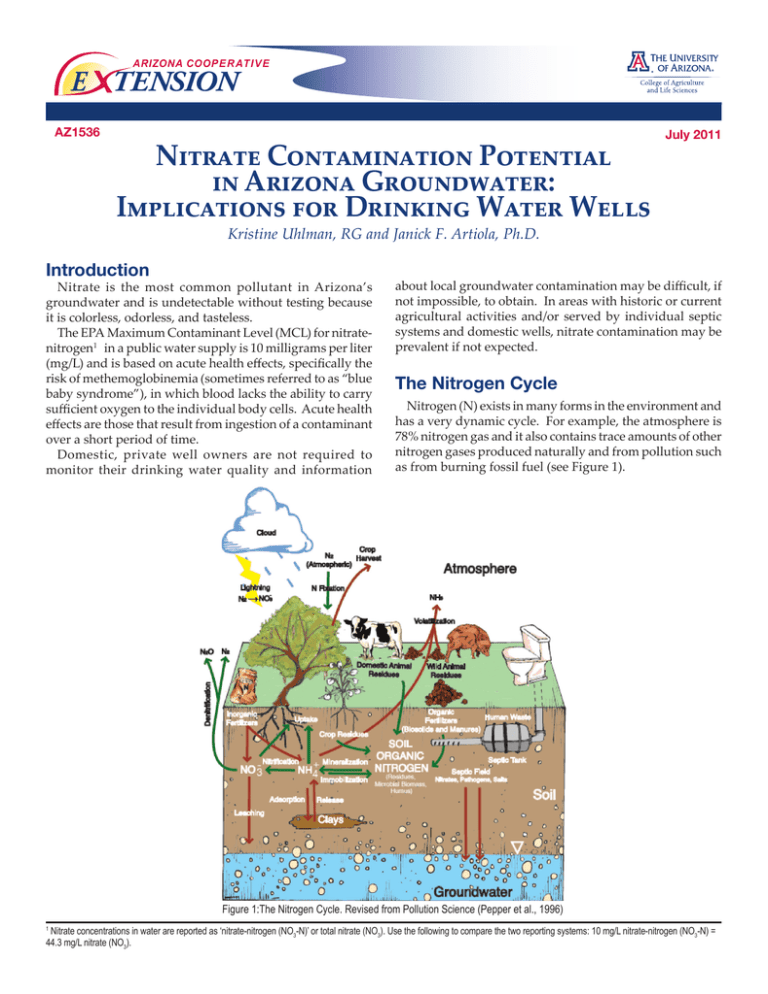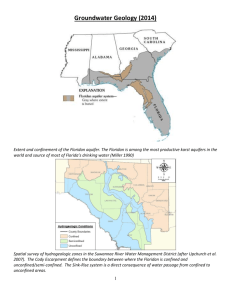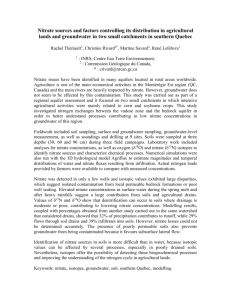Nitrate Contamination Potential in Arizona Groundwater: Implications for Drinking Water Wells
advertisement

ARIZONA COOP E R AT I V E E TENSION AZ1536 Nitrate Contamination Potential in Arizona Groundwater: Implications for Drinking Water Wells July 2011 Kristine Uhlman, RG and Janick F. Artiola, Ph.D. Introduction Nitrate is the most common pollutant in Arizona’s groundwater and is undetectable without testing because it is colorless, odorless, and tasteless. The EPA Maximum Contaminant Level (MCL) for nitratenitrogen1 in a public water supply is 10 milligrams per liter (mg/L) and is based on acute health effects, specifically the risk of methemoglobinemia (sometimes referred to as “blue baby syndrome”), in which blood lacks the ability to carry sufficient oxygen to the individual body cells. Acute health effects are those that result from ingestion of a contaminant over a short period of time. Domestic, private well owners are not required to monitor their drinking water quality and information about local groundwater contamination may be difficult, if not impossible, to obtain. In areas with historic or current agricultural activities and/or served by individual septic systems and domestic wells, nitrate contamination may be prevalent if not expected. The Nitrogen Cycle Nitrogen (N) exists in many forms in the environment and has a very dynamic cycle. For example, the atmosphere is 78% nitrogen gas and it also contains trace amounts of other nitrogen gases produced naturally and from pollution such as from burning fossil fuel (see Figure 1). Figure 1:The Nitrogen Cycle. Revised from Pollution Science (Pepper et al., 1996) Nitrate concentrations in water are reported as ‘nitrate-nitrogen (NO3-N)’ or total nitrate (NO3). Use the following to compare the two reporting systems: 10 mg/L nitrate-nitrogen (NO3-N) = 44.3 mg/L nitrate (NO3). 1 The soil environment contains many forms of N, including organic (carbon-based) forms produced from decaying plant and animal residues. During the decay process inorganic forms of N are also produced, including ammonia gas, which reacts with water to form ammonium, and nitrate. Nitrate is very mobile in soil and groundwater because, unlike ammonium, nitrate does not adsorb onto soil or aquifer geologic materials, and only precipitates as a mineral under dry conditions. However, in the soil environment nitrate can be taken up by plants and microorganisms and recycled back into plant and animal tissue or transformed into nitrous oxide or transformed back into harmless nitrogen gas, as shown in Figure 1. Nitrous oxide, produced in water-logged soils and by animals, is a ‘green-house’ gas, partly responsible for global warming. (see AZ Cooperative Extension Bulletin AZ1458). Fertilizers and Wastes Nitrogen gas from the atmosphere is used to produce ammonia gas, which can be applied directly as an N fertilizer to irrigation water, but requires special equipment and precautions due to its toxicity and volatility. Ammonia is most often used to produce easy-to-handle fertilizers, which include granular forms such as urea, and ammonium and nitrate salts. These N fertilizers can be applied to soils directly or in liquid forms (pre-dissolved in water, called ‘N solutions’), and in combination with other nutrients like phosphorus. Although plants prefer nitrate to ammonium, plants can take up both forms. There are economical and environmental benefits to the application of ammoniumbased fertilizer. Ammonium is cheaper than nitrate and is much less mobile than the nitrate ion in the soil environment. However, ammonium is quickly transformed to nitrate when applied to moist (irrigated) and warm soils of Arizona. The transformation occurs within days or weeks. Therefore, most of the inorganic nitrogen in welldrained soils is in the nitrate form. Nitrate groundwater contamination is common in agricultural areas and can occur due to 1) over-application of N fertilizer; 2) excessive irrigation; and/or; 3) poor N fertilizer application timing. render the water unfit for potable use. In addition, high nitrate levels occur in Marana, St. David, Bullhead City, and other areas in Arizona. Quartzsite and Lake Havasu City have made significant efforts to address wastewater disposal problems that have contributed to groundwater contamination. Septic system discharges are common nitrate sources in rural areas and this has contributed to the contamination of surface and groundwater in Arizona (ADEQ, 2006). Even properly designed and efficiently operating traditional septic tank/drain field systems discharge nitrate to the environment. Quartzsite, Bullhead City and Lake Havasu City are just a few locations with documented nitrate problems from septic systems. Predicting Locations of Possible Nitrate Groundwater Contamination The quality of drinking water supplied by public water systems is regulated by the Environmental Protection Agency and enforced by the Arizona Department of Environmental Quality (ADEQ). Information on nitrate in groundwater is available through annual water quality reports which suppliers must report to ADEQ. This data was used to develop a methodology to predict locations across the state vulnerable to nitrate contamination (Rahman, et al. 2009). Groundwater quality data for 6,802 Arizona drinking water well locations were used to map and tabulate well, environmental, and land use characteristics (attributes) for each location, as shown in Figure 2. Municipal and animal wastes are very rich in nitrogen and contain many forms of this element. Therefore, nitrate contamination of surface and groundwater is also commonly associated with domestic septic systems, wastewater treatment plants, and concentrated animal feedlots. Nitrate Groundwater Contamination in Arizona High concentrations of nitrate in groundwater are usually due to human activities, however, some nitrate (low mg/l) is naturally occurring in arid soils (Graham, et. al., 2008). Large portions of aquifers within the Salt River Valley, areas in Glendale, Mesa, Chandler and Phoenix, contain groundwater with nitrate concentrations high enough to 2 The University of Arizona Cooperative Extension Figure 2: ‘Multivariate logistic regression’ was used to relate the probability of nitrate concentrations based on known physical attributes at each of the 6,802 well locations. Environmental characteristics were tabulated for each location and included: geology; soils; population density; well depth; precipitation; and other factors, such as the presence of septic systems. A statistical analysis (Multivariate logistic regression) of the well data and associated water quality data predicted the chances (vulnerability) of groundwater to nitrate contamination in the areas of state where nitrate information is not available. This study showed that groundwater contamination potential is highest in areas also associated with agricultural land use. Not surprisingly, most productive soils in Arizona are located in the Basin and Range province of the state where most of the state’s groundwater resources sufficient to support agricultural irrigation are located (Artiola and Uhlman, 2009). Unfortunately, the porous soils and unconsolidated sedimentary geology of this region allow for the leaching of nitrate below the plant root zone to contaminate the groundwater. Lower concentrations across the Basin and Range in areas not known to have agricultural activities may be attributed to the deposition of naturally occurring nitrates in arid soils (Graham, et. al., 2008). Fractured consolidated rock (common in the Colorado Plateau and the mountain highlands) such as granite also favors nitrate groundwater contamination. Fractured rock aquifers do not filter septic sources as efficiently as porous aquifers, and septic systems installed in rock with insufficient filtering capacity can result in well water contamination. This study also showed that well depth is also a significant factor with shallower wells more likely to be contaminated by nitrates. Figures 3 and 4 show the areas of the state where the model as predicted varying chances of groundwater contamination. These figures show that, in general, the chances of having nitrate-nitrogen in groundwater are highest in the desert southwest region of the state – this could be due to both low-concentration naturally occurring nitrates as well as nitrates derived from historic agricultural practices. For example, in Figure 3, the areas mapped in red have a 90% to 100% chance (probability) that the nitratenitrogen contamination there is greater than 5 milligrams per liter (mg/L), half of the MCL of 10 milligrams per liter (mg/L). In Figure 4, the areas mapped in red have a 90% to 100% chance (probability) of nitrate-nitrogen contamination being greater than the drinking water MCL of 10 milligrams per liter (mg/L). Therefore, the red colored areas of Figure 4 indicate that wells installed within the agricultural regions of central Arizona, including portions of Phoenix and Casa Grande, are likely to be contaminated. Testing for Nitrate in Well Water Domestic well water used for drinking water supply should be tested annually to monitor changes in nitrate concentration. In addition, a water test is recommended for households with infants, pregnant women, nursing mothers, or elderly people. These groups are believed to be the most susceptible to nitrate health effects. Tests to determine the presence of nitrate in drinking water should be done by a State-certified laboratory approved for nitrate testing, listed with the Arizona Department of Health Services, Bureau of State Laboratory Services – http:// www.azdhs.gov/lab/license/. The selected laboratory will send you a special water sample container and sampling collection instructions. Follow these instructions carefully to obtain a representative sample. While a variety of test kits and dip strips are available for nitrate testing outside of a laboratory environment, laboratory analysis is needed for an accurate and reliable nitrate measurement. Options for Managing Nitrate Contamination in Your Well Water If nitrate exceeds a desirable concentration (recall footnote about the units on page one) in a domestic well, the well owner should consider an alternative drinking water source or water treatment. It may be possible to obtain an alternate water supply by drilling a new well in a different location or a deeper well in a different aquifer. Bottled water might be considered if the primary concern is water for infant food and drinking. Nitrate levels in drinking water can be lowered with any of three treatment methods: distillation, reverse osmosis, and ion exchange. Home treatment equipment using these processes is available from several manufacturers. For more information about home water treatment systems see Arizona Know Your Water booklet (Artiola et al., 2006), available from the College of Agriculture and Life Sciences (CALS) publications website. Note that carbon filters and standard water softeners do not remove nitrate. Merely boiling water may increase rather than decrease the nitrate concentration. References ADEQ, Arizona Department of Environmental Quality, 2008: Arizona 2006-2008 Integrated 305(b) and 303(d) Listing Reports. Phoenix, Arizona. http://www.azdeq.gov/environ/ water/assessment/assess.html Artiola, J.F., K.L. Farrell-Poe, and J.C. Moxley, 2006. Arizona Know Your Water. 2006. A consumer guide to water sources, quality, regulations and home water treatment options. University of Arizona, CALS. http://cals.arizona.edu/pubs/ Artiola., J.F. and K.Ulhman. 2009. Arizona Well Owner’s Guide to Water Supply. University of Arizona, CALS Extension bulletin AZ1485. http://cals.arizona.edu/pubs/ Graham, R.C., and D. R. Hirmas, Y. A Wood, C. Amrhein. 2008. Large near-surface nitrate pools in soils capped by desert pavement in the Mojave Desert, California. Geology; March, 2008; v. 36; no. 3; p. 259-262 Pepper, I.L., C.P. Gerba, M.L. Brusseau. 1996. Pollution Science. Academic Press. Rahman, T., and K. Uhlman: A. Posner; E. Westfall; P. Gunes. 2009. Predicting Ground Water Vulnerability to Nitrate in Arizona. University of Arizona, Water Resources Research Center Publication. Tucson, Arizona. http://www.ag.arizona. edu/azwater/publications.php?rcd_id=68 The University of Arizona Cooperative Extension 3 Figure 3: This figure shows predicted concentrations of nitrate-N in groundwater. Over 9% of the state, or 12,200 square miles, has an 80% chance (probability) of nitrate groundwater contamination exceeding 5 mg/L, half the drinking water MCL. Figure 4: This figure shows predicted concentrations of nitrate-N in groundwater. Less than 1% of the state, or 226 square miles, has an 80% chance (probability) of nitrate groundwater contamination exceeding the EPA MCL of 10 mg/L. ARIZONA COOP E R AT I V E E TENSION THE UNIVERSITY OF ARIZONA COLLEGE OF AGRICULTURE AND LIFE SCIENCES The University of Arizona College of Agriculture and Life Sciences Tucson, Arizona 85721 Kristine Uhlman, RG Area Assistant Agent, Natural Resources Janick Artiola, PhD. Associate Professor and Water Quality Specialist Department of Soil, Water & Environmental Sciences Contact: Janick Artiola jartiola@cals.arizona.edu This information has been reviewed by University faculty. cals.arizona.edu/pubs/water/az1536.pdf Other titles from Arizona Cooperative Extension can be found at: cals.arizona.edu/pubs Any products, services or organizations that are mentioned, shown or indirectly implied in this publication do not imply endorsement by The University of Arizona. Issued in furtherance of Cooperative Extension work, acts of May 8 and June 30, 1914, in cooperation with the U.S. Department of Agriculture, Kirk A. Astroth, Interim Director, Cooperative Extension, College of Agriculture Life Sciences, The University of Arizona. The University of Arizona is an equal opportunity, affirmative action institution. The University does not discriminate on the basis of race, color, religion, sex, national origin, age, disability, veteran status, or sexual orientation in its programs and activities. 4 The University of Arizona Cooperative Extension








